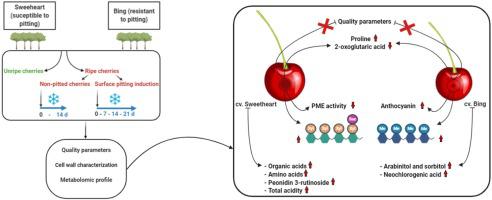Postharvest Biology and Technology ( IF 7 ) Pub Date : 2021-02-10 , DOI: 10.1016/j.postharvbio.2021.111494 Excequel Ponce , Blanca Alzola , Natalia Cáceres , Madeline Gas , Catalina Ferreira , Juan Vidal , Rosana Chirinos , David Campos , Miguel Rubilar , Reinaldo Campos-Vargas , Romina Pedreschi , Claudia Fuentealba

|
One important physiological disorder in sweet cherry (Prunus avium L.) is surface pitting. This disorder involves irregular depressions on the fruit surface and occurs during harvest, but it develops during cold storage. The aim of this research was to understand the phenotypic characteristics and biochemical responses, referring to the metabolomic profile and the composition and disassembly of the cell wall, that underlie the susceptibility to pitting. The study was carried out using cultivars with contrasting pitting behaviors, such as Bing (resistant) and Sweetheart (sensitive), during ripening and postharvest storage. Induced pitting did not have a negative impact on quality parameters except visual quality in sweet cherries during cold storage, and firmness was not a key parameter that explained the susceptibility to pitting. The mechanical stress to induce pitting triggered a significant decline in pectin methylesterase (PME) activity on day 14 of storage for the Sweetheart cultivar. Intensified labeling for methylated homogalacturonan immunostaining of pitted mesocarp cells in Bing was observed. Xyloglucan showed more abundant labeling in pitted samples, which was more pronounced in Sweetheart fruit than Bing cherries. The metabolomic screening showed a higher content of organic acids and amino acids in the Sweetheart cultivar, while the Bing cultivar had higher contents of sorbitol and arabinitol. Proline and 2-oxoglutaric acid emerged as metabolites altered in response to mechanical stress in both cultivars. Furthermore, pitted Bing fruit elicits anthocyanin overexpression. The metabolomic analysis suggests that susceptibility to pitting could depend on the metabolic differences of each cultivar because the induced pitting did not greatly disrupt the studied metabolic responses.
中文翻译:

甜樱桃(Prunus avium L.)栽培品种表面诱变的生化和表型特征
甜樱桃(李属樱桃)中的一种重要的生理疾病L.)是表面点蚀。这种疾病涉及果实表面的不规则凹陷,发生在收获期间,但在冷藏时会发展。这项研究的目的是了解表型特征和生化反应,涉及代谢组学特征以及细胞壁的组成和分解,这是点蚀的基础。这项研究是在成熟和收获后储存期间,使用具有对比点蚀行为的品种进行的,例如Bing(抗性)和Sweetheart(敏感)。除了在冷藏过程中甜樱桃的视觉质量外,诱导的点蚀对质量参数没有负面影响,并且硬度不是解释点蚀敏感性的关键参数。诱导点蚀的机械应力在甜心品种的储存第14天导致果胶甲基酯酶(PME)活性显着下降。观察到了Bing凹陷的中果皮细胞甲基化的同型半乳糖醛酸聚糖免疫染色的增强标记。木葡聚糖在去核样品中显示出更丰富的标记,在甜心果中比冰樱桃更明显。代谢组学筛选显示,甜心品种中有机酸和氨基酸的含量较高,而必应品种中的山梨醇和阿拉伯糖醇含量较高。脯氨酸和2-氧戊二酸作为代谢物响应于机械胁迫而出现。此外,去核的Bing水果会引起花青素过表达。



























 京公网安备 11010802027423号
京公网安备 11010802027423号